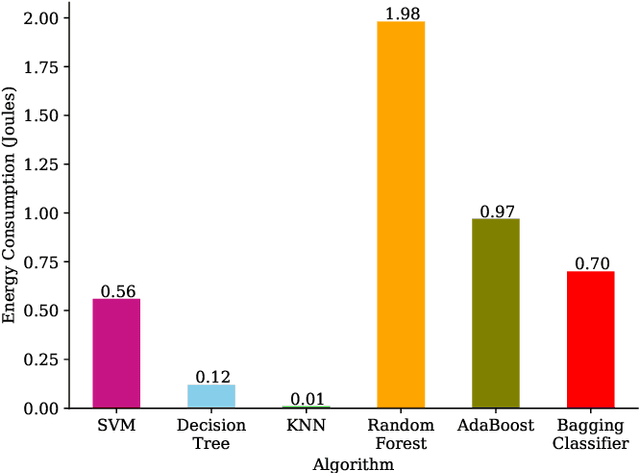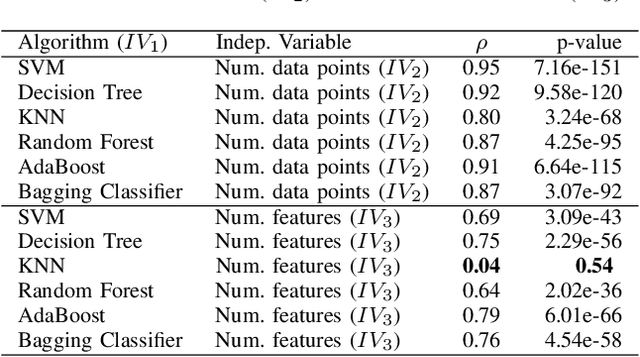June Sallou
Can We Make Code Green? Understanding Trade-Offs in LLMs vs. Human Code Optimizations
Mar 26, 2025Abstract:The rapid technological evolution has accelerated software development for various domains and use cases, contributing to a growing share of global carbon emissions. While recent large language models (LLMs) claim to assist developers in optimizing code for performance and energy efficiency, their efficacy in real-world scenarios remains under exploration. In this work, we explore the effectiveness of LLMs in reducing the environmental footprint of real-world projects, focusing on software written in Matlab-widely used in both academia and industry for scientific and engineering applications. We analyze energy-focused optimization on 400 scripts across 100 top GitHub repositories. We examine potential 2,176 optimizations recommended by leading LLMs, such as GPT-3, GPT-4, Llama, and Mixtral, and a senior Matlab developer, on energy consumption, memory usage, execution time consumption, and code correctness. The developer serves as a real-world baseline for comparing typical human and LLM-generated optimizations. Mapping these optimizations to 13 high-level themes, we found that LLMs propose a broad spectrum of improvements--beyond energy efficiency--including improving code readability and maintainability, memory management, error handling while the developer overlooked some parallel processing, error handling etc. However, our statistical tests reveal that the energy-focused optimizations unexpectedly negatively impacted memory usage, with no clear benefits regarding execution time or energy consumption. Our qualitative analysis of energy-time trade-offs revealed that some themes, such as vectorization preallocation, were among the common themes shaping these trade-offs. With LLMs becoming ubiquitous in modern software development, our study serves as a call to action: prioritizing the evaluation of common coding practices to identify the green ones.
Breaking the Silence: the Threats of Using LLMs in Software Engineering
Dec 13, 2023Abstract:Large Language Models (LLMs) have gained considerable traction within the Software Engineering (SE) community, impacting various SE tasks from code completion to test generation, from program repair to code summarization. Despite their promise, researchers must still be careful as numerous intricate factors can influence the outcomes of experiments involving LLMs. This paper initiates an open discussion on potential threats to the validity of LLM-based research including issues such as closed-source models, possible data leakage between LLM training data and research evaluation, and the reproducibility of LLM-based findings. In response, this paper proposes a set of guidelines tailored for SE researchers and Language Model (LM) providers to mitigate these concerns. The implications of the guidelines are illustrated using existing good practices followed by LLM providers and a practical example for SE researchers in the context of test case generation.
The Two Faces of AI in Green Mobile Computing: A Literature Review
Jul 21, 2023



Abstract:Artificial intelligence is bringing ever new functionalities to the realm of mobile devices that are now considered essential (e.g., camera and voice assistants, recommender systems). Yet, operating artificial intelligence takes up a substantial amount of energy. However, artificial intelligence is also being used to enable more energy-efficient solutions for mobile systems. Hence, artificial intelligence has two faces in that regard, it is both a key enabler of desired (efficient) mobile functionalities and a major power draw on these devices, playing a part in both the solution and the problem. In this paper, we present a review of the literature of the past decade on the usage of artificial intelligence within the realm of green mobile computing. From the analysis of 34 papers, we highlight the emerging patterns and map the field into 13 main topics that are summarized in details. Our results showcase that the field is slowly increasing in the past years, more specifically, since 2019. Regarding the double impact AI has on the mobile energy consumption, the energy consumption of AI-based mobile systems is under-studied in comparison to the usage of AI for energy-efficient mobile computing, and we argue for more exploratory studies in that direction. We observe that although most studies are framed as solution papers (94%), the large majority do not make those solutions publicly available to the community. Moreover, we also show that most contributions are purely academic (28 out of 34 papers) and that we need to promote the involvement of the mobile software industry in this field.
Batching for Green AI -- An Exploratory Study on Inference
Jul 21, 2023Abstract:The batch size is an essential parameter to tune during the development of new neural networks. Amongst other quality indicators, it has a large degree of influence on the model's accuracy, generalisability, training times and parallelisability. This fact is generally known and commonly studied. However, during the application phase of a deep learning model, when the model is utilised by an end-user for inference, we find that there is a disregard for the potential benefits of introducing a batch size. In this study, we examine the effect of input batching on the energy consumption and response times of five fully-trained neural networks for computer vision that were considered state-of-the-art at the time of their publication. The results suggest that batching has a significant effect on both of these metrics. Furthermore, we present a timeline of the energy efficiency and accuracy of neural networks over the past decade. We find that in general, energy consumption rises at a much steeper pace than accuracy and question the necessity of this evolution. Additionally, we highlight one particular network, ShuffleNetV2(2018), that achieved a competitive performance for its time while maintaining a much lower energy consumption. Nevertheless, we highlight that the results are model dependent.
Uncovering Energy-Efficient Practices in Deep Learning Training: Preliminary Steps Towards Green AI
Mar 24, 2023Abstract:Modern AI practices all strive towards the same goal: better results. In the context of deep learning, the term "results" often refers to the achieved accuracy on a competitive problem set. In this paper, we adopt an idea from the emerging field of Green AI to consider energy consumption as a metric of equal importance to accuracy and to reduce any irrelevant tasks or energy usage. We examine the training stage of the deep learning pipeline from a sustainability perspective, through the study of hyperparameter tuning strategies and the model complexity, two factors vastly impacting the overall pipeline's energy consumption. First, we investigate the effectiveness of grid search, random search and Bayesian optimisation during hyperparameter tuning, and we find that Bayesian optimisation significantly dominates the other strategies. Furthermore, we analyse the architecture of convolutional neural networks with the energy consumption of three prominent layer types: convolutional, linear and ReLU layers. The results show that convolutional layers are the most computationally expensive by a strong margin. Additionally, we observe diminishing returns in accuracy for more energy-hungry models. The overall energy consumption of training can be halved by reducing the network complexity. In conclusion, we highlight innovative and promising energy-efficient practices for training deep learning models. To expand the application of Green AI, we advocate for a shift in the design of deep learning models, by considering the trade-off between energy efficiency and accuracy.
A Systematic Review of Green AI
Jan 31, 2023Abstract:With the ever-growing adoption of AI-based systems, the carbon footprint of AI is no longer negligible. AI researchers and practitioners are therefore urged to hold themselves accountable for the carbon emissions of the AI models they design and use. This led in recent years to the appearance of researches tackling AI environmental sustainability, a field referred to as Green AI. Despite the rapid growth of interest in the topic, a comprehensive overview of Green AI research is to date still missing. To address this gap, in this paper, we present a systematic review of the Green AI literature. From the analysis of 98 primary studies, different patterns emerge. The topic experienced a considerable growth from 2020 onward. Most studies consider monitoring AI model footprint, tuning hyperparameters to improve model sustainability, or benchmarking models. A mix of position papers, observational studies, and solution papers are present. Most papers focus on the training phase, are algorithm-agnostic or study neural networks, and use image data. Laboratory experiments are the most common research strategy. Reported Green AI energy savings go up to 115%, with savings over 50% being rather common. Industrial parties are involved in Green AI studies, albeit most target academic readers. Green AI tool provisioning is scarce. As a conclusion, the Green AI research field results to have reached a considerable level of maturity. Therefore, from this review emerges that the time is suitable to adopt other Green AI research strategies, and port the numerous promising academic results to industrial practice.
Data-Centric Green AI: An Exploratory Empirical Study
Apr 07, 2022



Abstract:With the growing availability of large-scale datasets, and the popularization of affordable storage and computational capabilities, the energy consumed by AI is becoming a growing concern. To address this issue, in recent years, studies have focused on demonstrating how AI energy efficiency can be improved by tuning the model training strategy. Nevertheless, how modifications applied to datasets can impact the energy consumption of AI is still an open question. To fill this gap, in this exploratory study, we evaluate if data-centric approaches can be utilized to improve AI energy efficiency. To achieve our goal, we conduct an empirical experiment, executed by considering 6 different AI algorithms, a dataset comprising 5,574 data points, and two dataset modifications (number of data points and number of features). Our results show evidence that, by exclusively conducting modifications on datasets, energy consumption can be drastically reduced (up to 92.16%), often at the cost of a negligible or even absent accuracy decline. As additional introductory results, we demonstrate how, by exclusively changing the algorithm used, energy savings up to two orders of magnitude can be achieved. In conclusion, this exploratory investigation empirically demonstrates the importance of applying data-centric techniques to improve AI energy efficiency. Our results call for a research agenda that focuses on data-centric techniques, to further enable and democratize Green AI.
 Add to Chrome
Add to Chrome Add to Firefox
Add to Firefox Add to Edge
Add to Edge